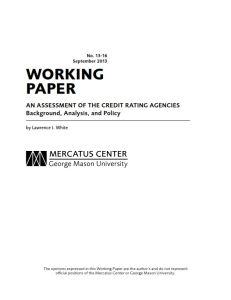Join getAbstract to access the summary!

Join getAbstract to access the summary!
Lawrence J. White
An Assessment of the Credit Rating Agencies
Background, Analysis, and Policy
Mercatus Center, 2013
What's inside?
This contrarian view on the regulation of bond credit rating agencies says the government should step back.
Recommendation
Stern School of Business professor Lawrence J. White outlines the history of credit rating agencies (CRAs) and traces related federal legislation from the establishment of the Securities and Exchange Commission in 1930 onward. White contends that intertwining bond ratings with “regulatory reliance” has been disruptive and that CRAs meet no current market need. His paper, issued by the conservative Mercatus Center at George Mason University, says improved models could foster competition. White’s contrarian views on the drawbacks of the present regulatory environment carry weight, but likely would not win approval from reigning experts. getAbstract believes that bondholders and traders who are interested in an out-of-the-box analysis from the right-hand side of the economic-thought spectrum will find this an intriguing, contrary read – as will others who wonder what happened to real estate values in the first decade of the 21st century.
Summary
About the Author
Lawrence J. White, a writer and researcher in applied microeconomics, financial regulation and international banking, is a professor at the Stern School of Business.
















Comment on this summary